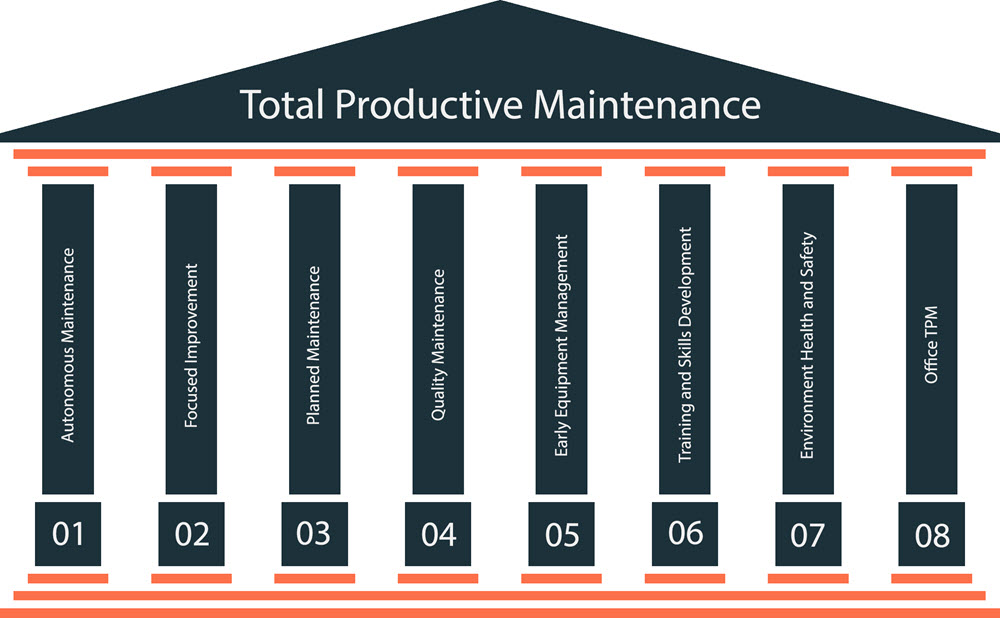Introduction
Total Productive Maintenance (TPM) is a maintenance strategy that aims to involve all employees in the maintenance process, from operators to managers, to improve the overall performance of the organization. TPM is a holistic approach that focuses on maximizing the efficiency and effectiveness of equipment, processes, and people. The goal of TPM is to minimize downtime, reduce costs, and improve the quality of products or services.
Implementing TPM
Implementing TPM can be a challenging process, but it is worth the effort as it can bring significant benefits to the organization. The following are the steps that organizations can take to implement TPM.
Establish a TPM Team
The first step in implementing TPM is to establish a TPM team. The team should be made up of representatives from all levels of the organization, including operators, maintenance personnel, and managers. The team should be responsible for developing and implementing the TPM program.
Conduct a TPM Assessment
The next step is to conduct a TPM assessment. This assessment should identify the current state of the organization’s equipment, processes, and people. The assessment should also identify the areas where improvements can be made.
Develop a TPM Plan
Based on the results of the TPM assessment, the TPM team should develop a TPM plan. The plan should include specific goals and objectives, as well as a timeline for implementation. The plan should also include a detailed implementation strategy, including the resources that will be required to implement total productive maintenance (TPM).
Implement Total Productive Maintenance
Once the TPM plan has been developed, it is time to implement TPM. The TPM team should work with all employees to implement the TPM program. This may involve training employees on the TPM process, as well as providing them with the tools and equipment they need to perform their duties.
Monitor and Evaluate TPM
The final step in implementing total productive maintenance, is to monitor and evaluate the program. The TPM team should track the progress of the program and make adjustments as needed. They should also evaluate the program’s effectiveness and make changes as necessary to improve performance.
Benefits of Total Productive Maintenance (TPM)
TPM has been shown to bring several benefits to organizations, as outlined below.
Increased Equipment Uptime
One of the biggest benefits of TPM is that it can increase the uptime of equipment. By involving all employees in the maintenance process, TPM can help to identify and resolve issues before they cause equipment downtime.
Reduced Costs
TPM can also help to reduce costs. By increasing equipment uptime and improving the efficiency of processes, TPM can help to reduce the costs associated with downtime and repairs.
Improved Product Quality
TPM can also improve the quality of products or services. By identifying and resolving issues early, TPM can help to improve the quality of products or services.
Increased Employee Involvement
TPM can also increase employee involvement. By involving all employees in the maintenance process, TPM can help to create a sense of ownership and commitment among employees.
Improved Safety
TPM can also improve safety. By identifying and resolving issues early, TPM can help to reduce the risk of accidents and injuries.
Conclusion
Total Productive Maintenance (TPM) is a maintenance strategy that aims to involve all employees in the maintenance process, from operators to managers, to improve the overall performance of the organization. TPM is a holistic approach that focuses on maximizing the efficiency and effectiveness of equipment, processes, and people. Implementing TPM can be a challenging process, but it is worth the effort as it can bring significant benefits to the organization, such as increased equipment uptime, reduced costs, improved product quality, increased employee involvement, and improved safety.
To successfully implement TPM, organizations should establish a TPM team, conduct a TPM assessment, develop a TPM plan, implement TPM, and monitor and evaluate the program. It is important to note that TPM is not a one-time event but rather an ongoing process that requires commitment and continuous improvement.
Overall, TPM is a valuable approach for organizations looking to improve their maintenance processes and increase their overall performance. By involving all employees in the maintenance process, TPM can help to identify and resolve issues early, reduce downtime, reduce costs, improve product quality, and increase employee involvement and safety.






